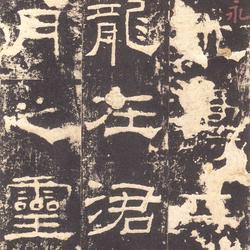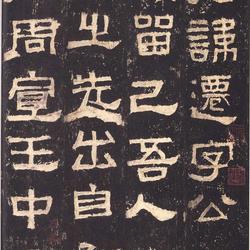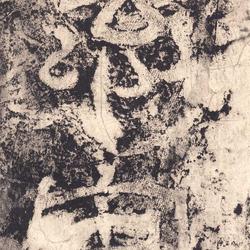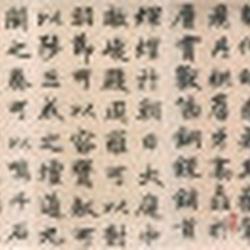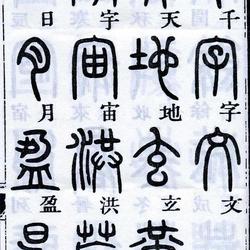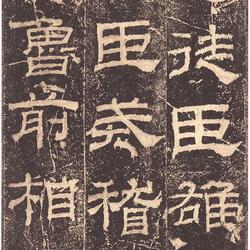Zhao Mengfu's "Records of Miaoyan Temple in Huzhou"
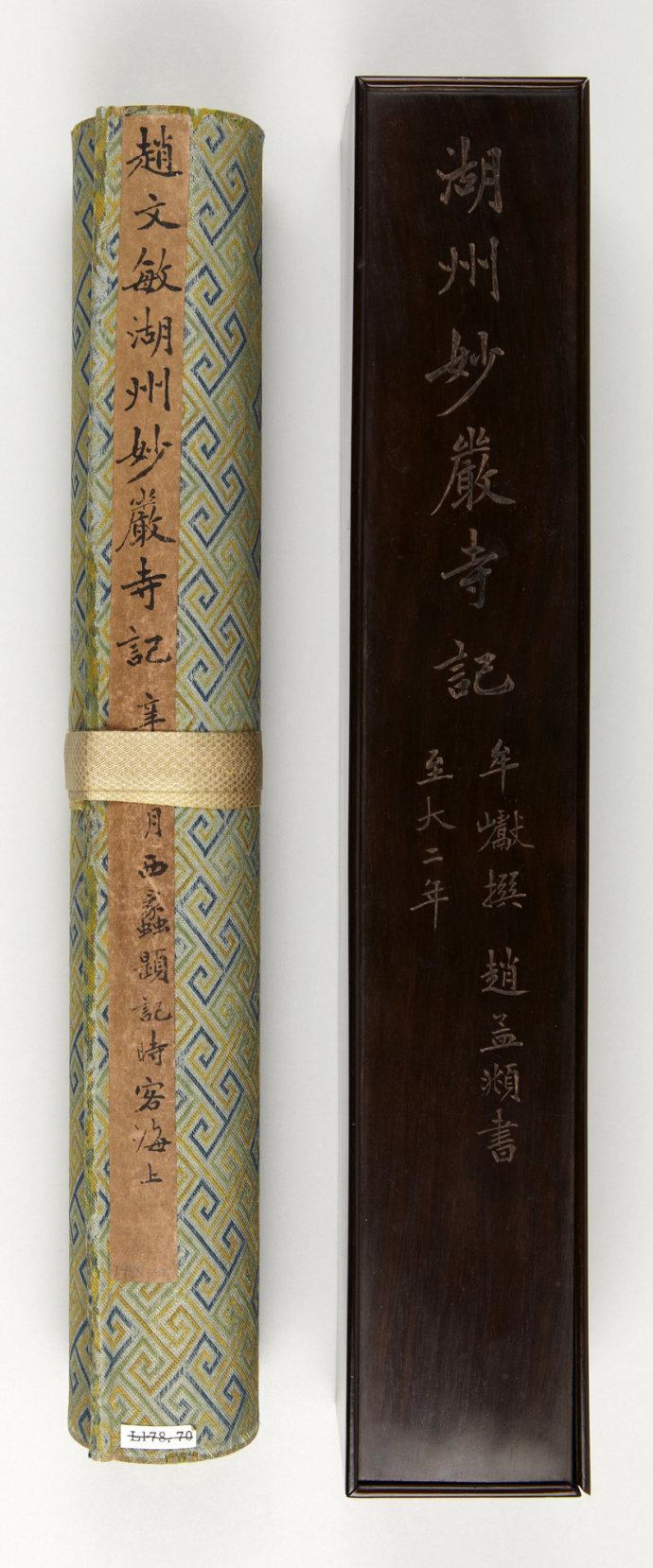
"Huzhou Miaoyan Temple" hand scroll, work size: 34.2 x 364.5 cm, inscription size: 34.6 x 206.7 cm
Written by Mou Xian, written by Zhao Mengfu with seal on the forehead, undated, the original paper is scrolled horizontally and is now in the collection of the Princeton University Art Museum in the United States.

Huzhou Miaoyan Temple Expand the picture (click on the picture to enlarge it)
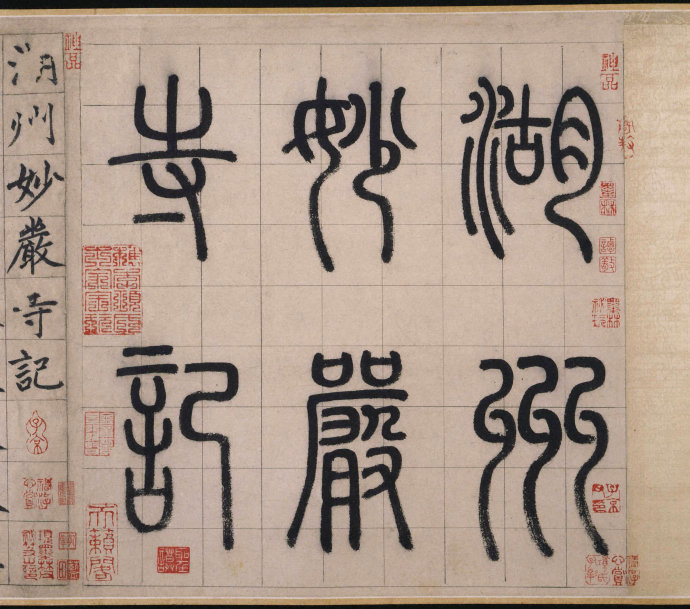
The six large characters on the inscription of "Huzhou Miaoyan Temple" are written in seal script, and the rest of the entire work is written in regular script. The handwriting is well-proportioned, the strokes are round, vigorous and smooth, and the structural layout is dignified and beautiful. The strokes are open and stretched, the stippling is exquisite, and the turns are flexible. It is elegant and elegant in the solemn and regular style. It has extremely high calligraphy attainments and is the best model for future generations to learn Zhao's regular script.
"Huzhou Miaoyan Temple Record Volume" is written on white paper with black silk columns. The characters are larger than one inch. In addition to the title and the name at the beginning of the article, the names of the authors and calligraphers are not included. The full text has 84 lines, each line has 9 characters, a total of 756 words. .
"Records of Miaoyan Temple in Huzhou" is an article written by Mou Gong describing the construction of Miaoyan Temple at that time, the engraving of the Huayan Sutra, the Lotus Sutra and the collection of the Tripitaka.
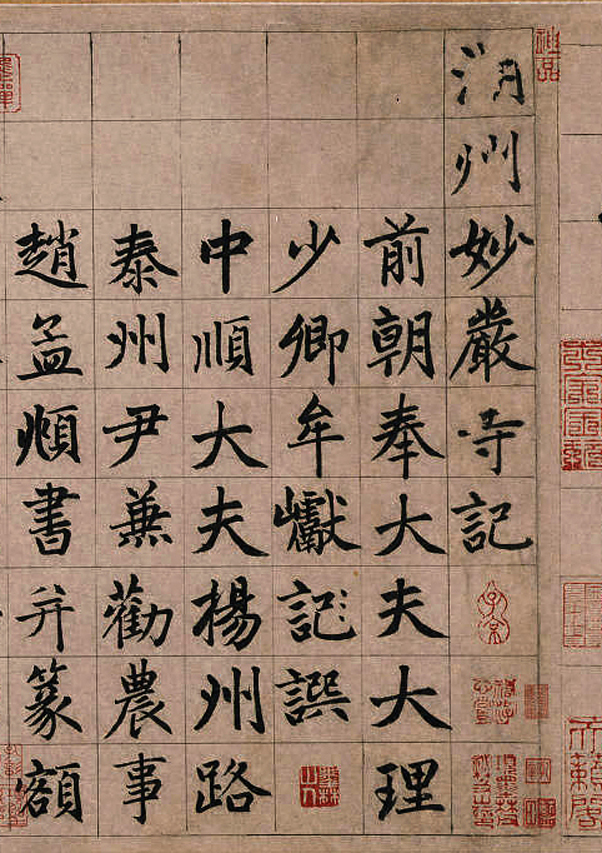
The author Mou Jian (Xianfu), a native of Sichuan, served as Shaoqing of Dali Temple in the Southern Song Dynasty. Later, due to the capture of Lin'an by the Yuan army, he refused to leave his home and became an official. He lived in seclusion in Nanyuan, his hometown in Huzhou, for thirty-six years, with Zhao Mengfu. Neighbor, died at the age of eighty-five. Zhao Mengfu was 27 years younger and was a close friend. Zhao Mengfu wrote articles such as "Records of Baoyun Temple in Songjiang", "Records of Rebuilding Confucianism in Jiaxing", "Inscriptions on Miaoyan Temple in Huzhou", etc.
This work is not signed with a date and month, but according to the title he signed - Zhongshun doctor Yangzhou Road Taizhou Yin and admonishing farmers, it can be speculated that this volume was written after July of the second year of Zhida (1309), or Before September of the following year. According to Yang Zai's "Zhao Wenmin Gong's Journey": "In July of the second year of his reign, he was promoted to Zhongshun Dafu, Yangzhou Road, Taizhou Yin, and Jianjin Farmer. He was not promoted yet. Emperor Renzong was in the East Palace and sent an envoy to summon him." It can be seen that Although he was appointed to this position, he did not take up the post. He was at home in Huzhou at this time. It was not until September of the following year that he was called to Dadu (today's Beijing). Therefore, we know that this volume was written when he was fifty-six or fifty-seven years old, and it was a work later in his middle period.
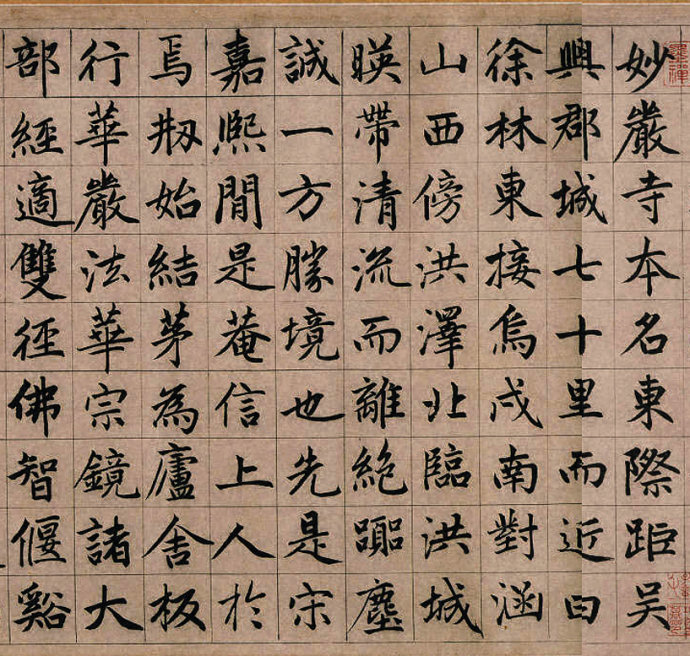
The original name of Miaoyan Temple is Dongji. It is seventy miles away from Wuxing County and close to Xulin. It borders Wuxu in the east, Hanshan Mountain in the south, Hongze in the west and Hongcheng in the north. Miaoyan Temple, formerly known as Dongji Temple, is located at the junction of Rongjia Tudou Village in Shuanglin Town and Zhuzi Tudou Village in Lianshi Town, 3 miles away from Xulin Village in Lianshi Town. In "Huzhou Miaoyan Temple Records", Wuxu is Wuzhen, Hanshan is Hanshan, Hongze is Hongzetang River at the junction of the two villages, and Hongcheng is Hongcheng (provincial cultural protection unit) in Mayao. Today, the two villages The Miaoyan Temple at the junction is no longer there, but the three-hole stone bridge on the west side of the Miaoyan Temple - Miaoyan Tang Bridge is still there.
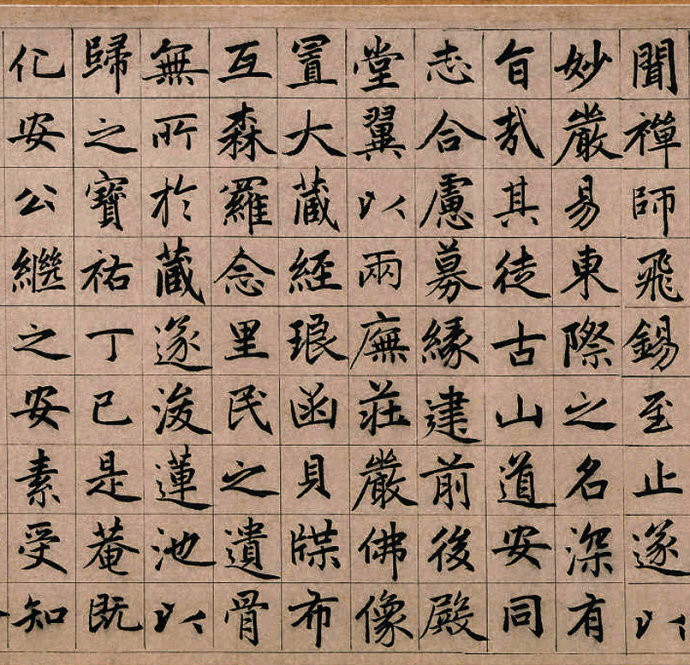
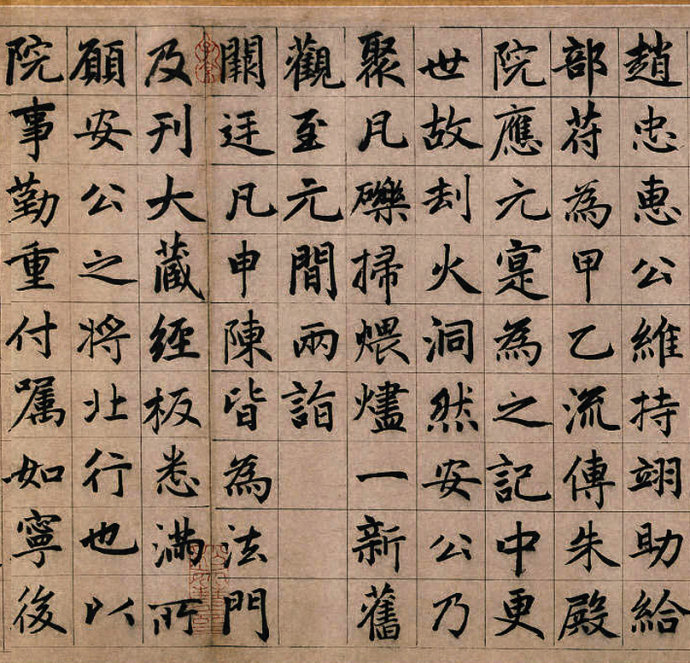
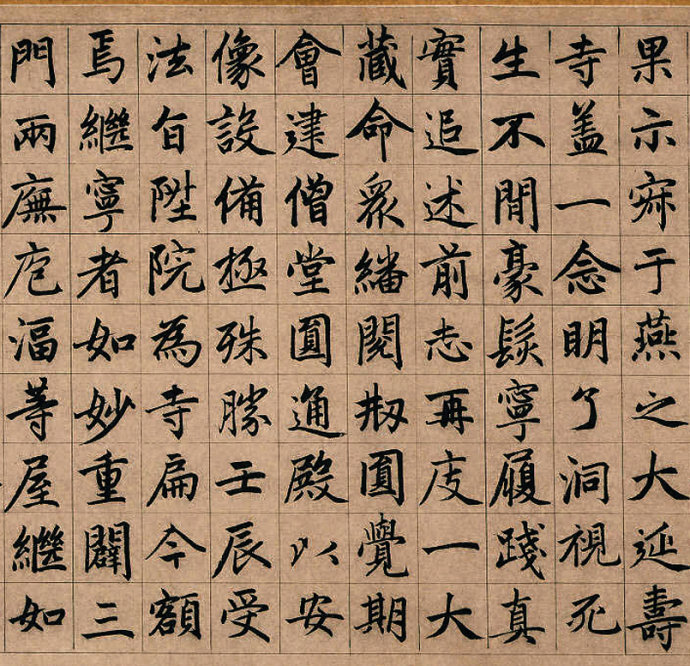
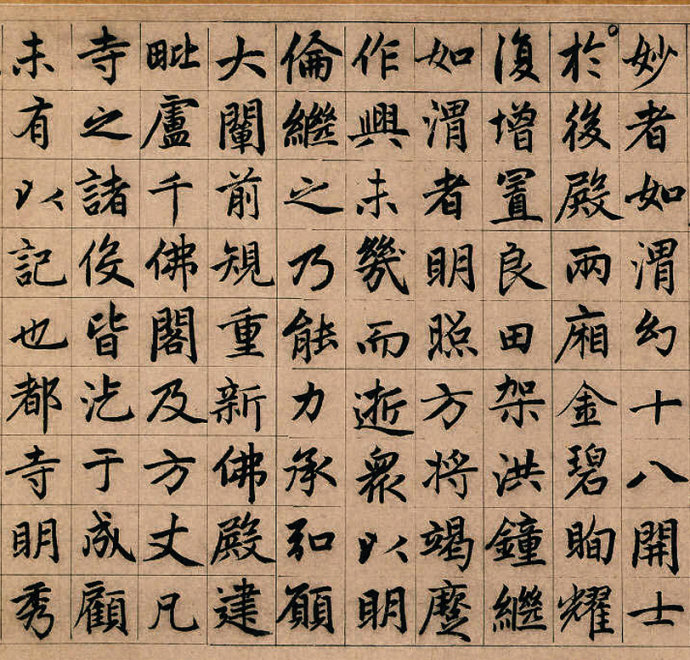
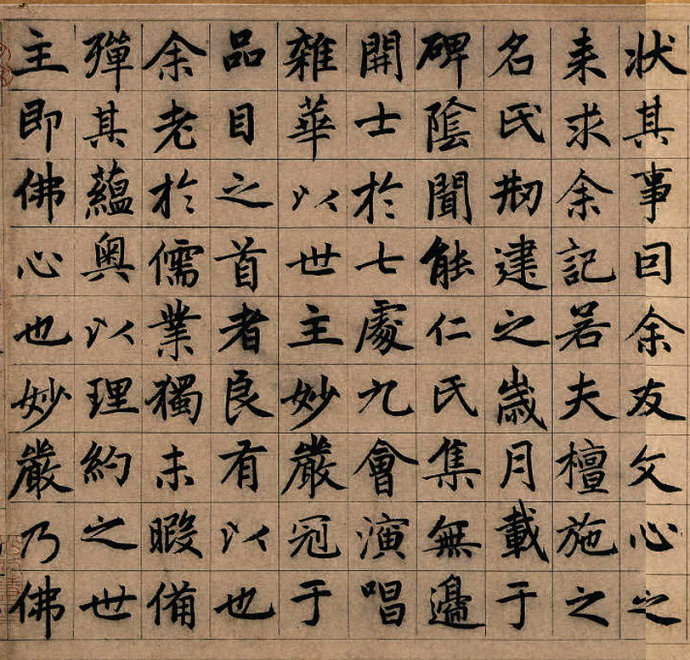
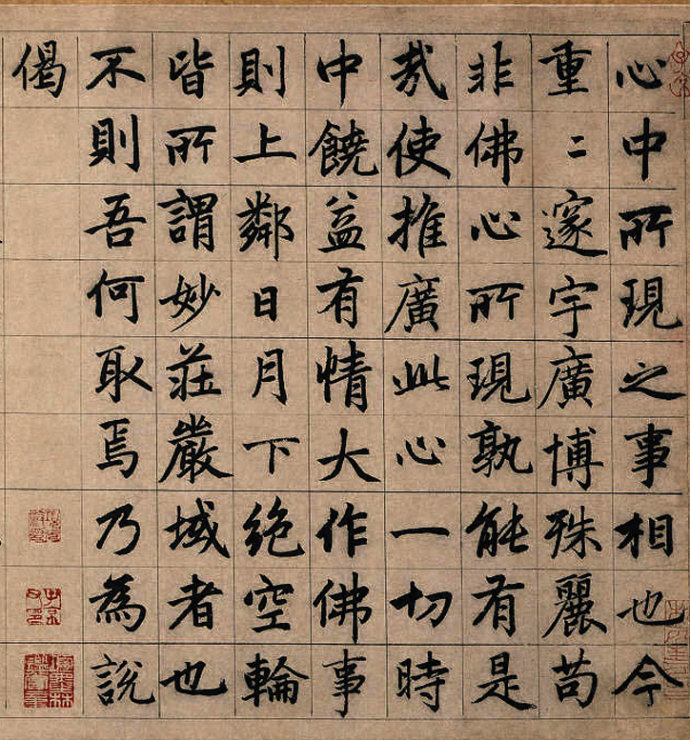
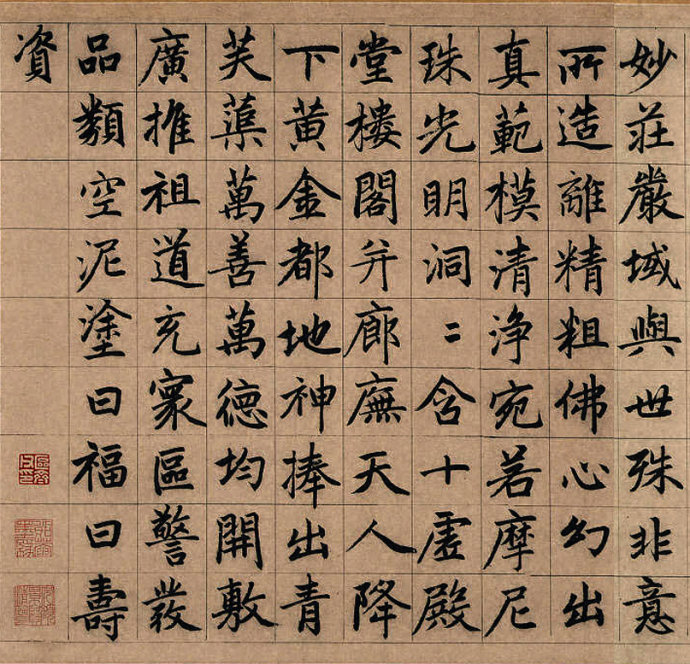
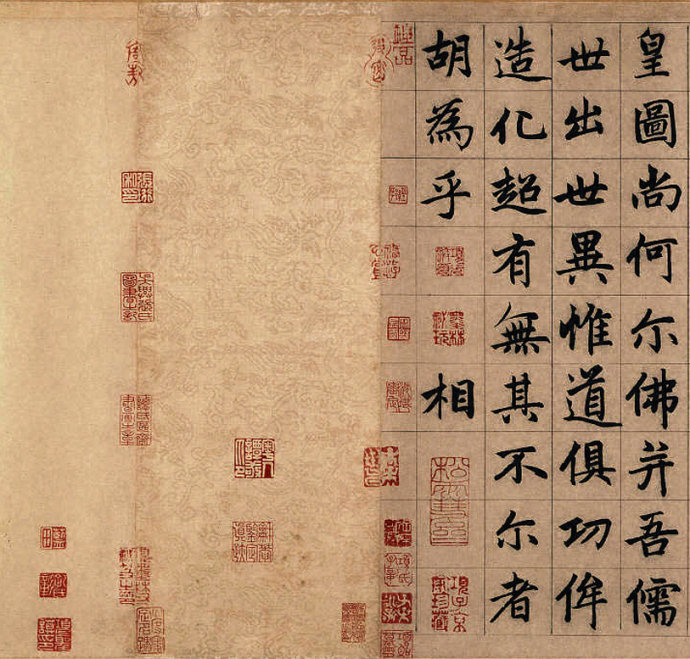
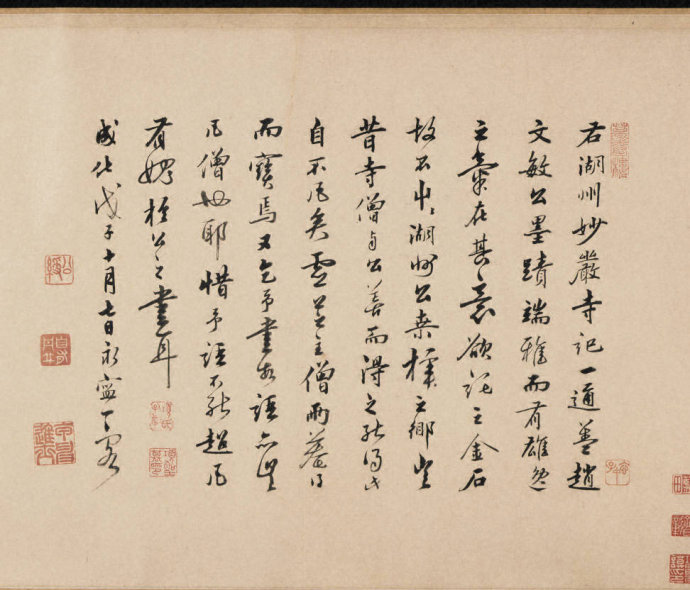
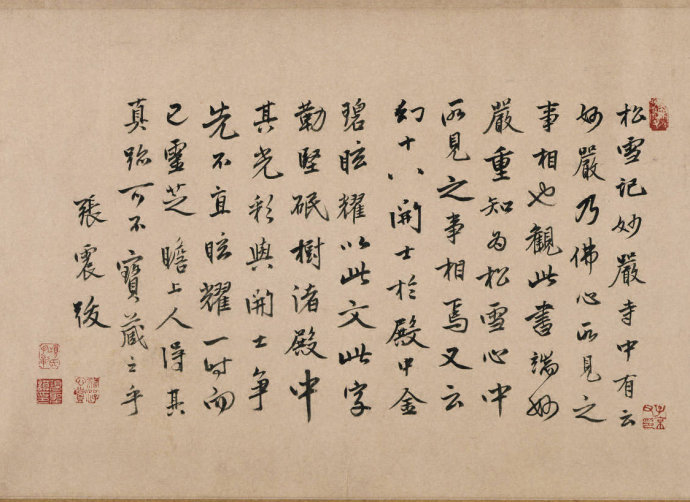
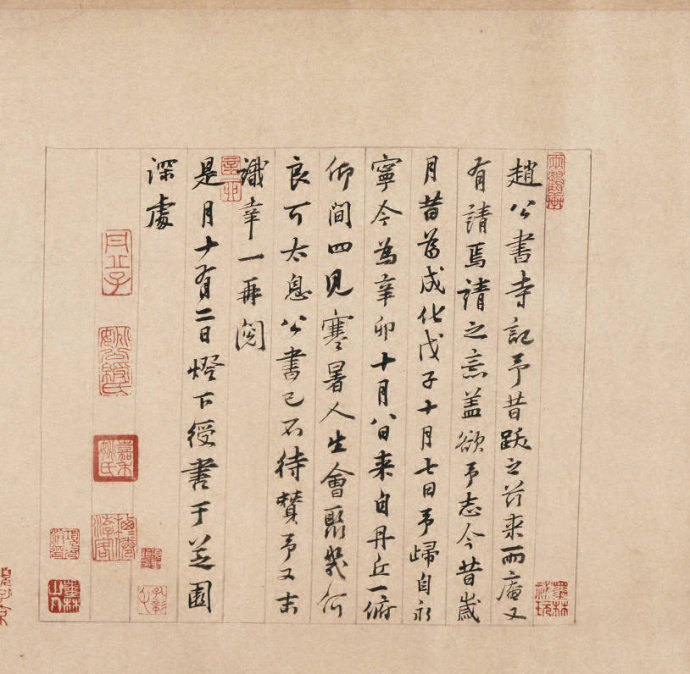
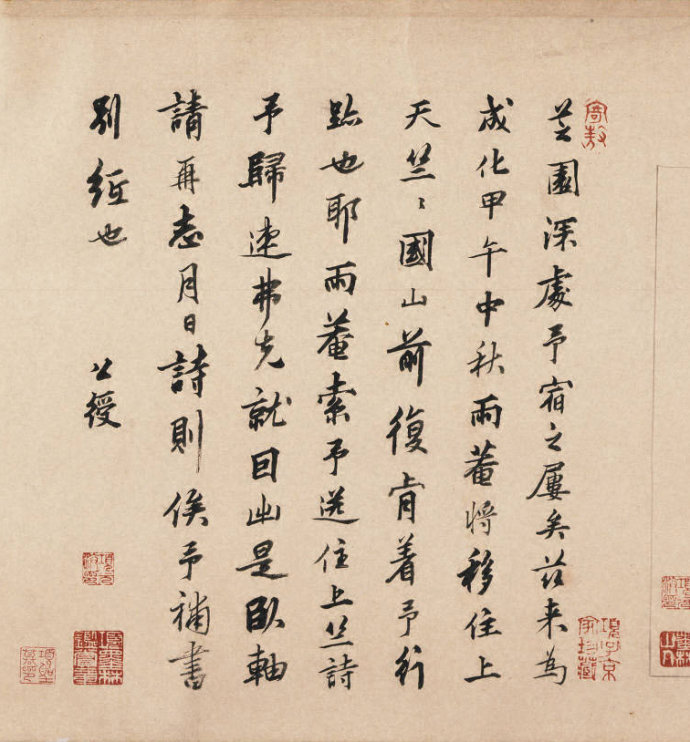
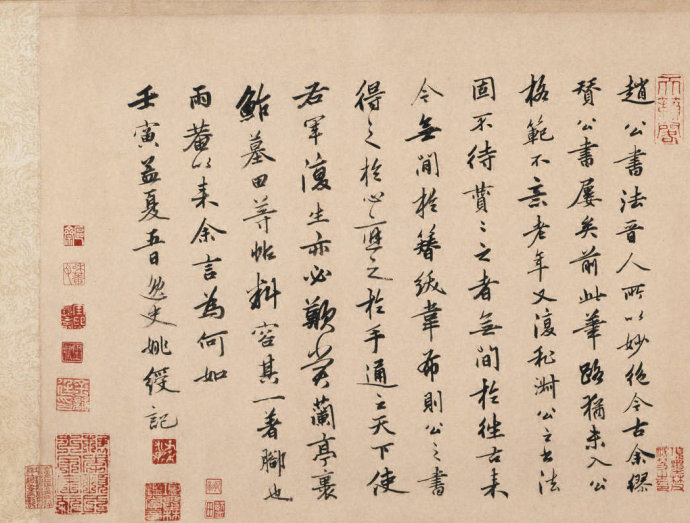
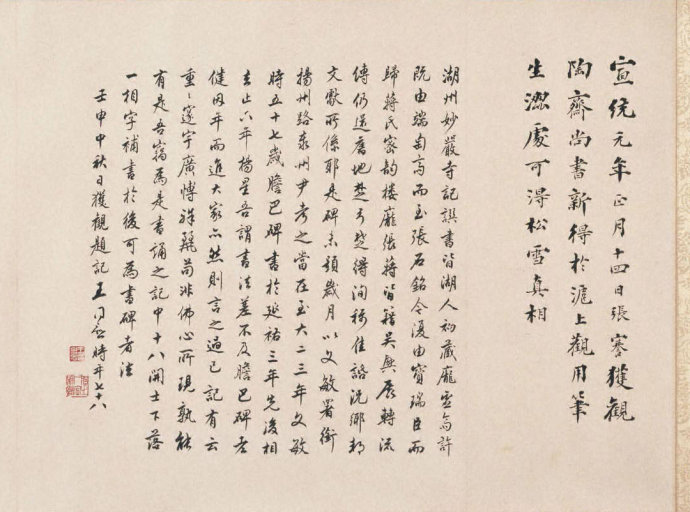
How did "Huzhou Miaoyan Temple" end up in the United States?
According to the inscription, this "Huzhou Miaoyan Temple Record Volume" was owned by the monk Yu'an at that time, and the "Huzhou Miaoyan Temple Record Volume" is well preserved as new. In the early years of the Republic of China, this volume was collected by the great collector Ye Gongchuo (Yu Hu) (after liberation, Ye served as deputy director of the Central Museum of Literature and History and president of the Beijing Academy of Fine Arts). Later, it was collected by the great collector Tan Jing (Ou Zhai). This volume was brought to Taiwan by Tan's wife and returned to the collection of the Princeton University Museum in the United States in 1970.
【Zhao Mengfu】
Zhao Songxue (1254-1322), also known as Zhao Mengfu, was a famous painter in the Yuan Dynasty and one of the four masters of regular script (Ouyang Xun, Yan Zhenqing, Liu Gongquan, and Zhao Mengfu). He was erudite and talented, good at poetry and prose, knowledgeable about economics, skilled in calligraphy, fine painting, good at epigraphy, and proficient in epigraphy. Lv Lu, interpreter of appreciation. In particular, he has the highest achievements in calligraphy and painting. He created a new style of painting in the Yuan Dynasty and is known as the "Crown of the Yuan Dynasty". He is also good at seal script, official script, Zhen script, running script and cursive script, and is especially famous for his regular script and running script. .
【Moucheng】
Mou Ji (1227-1311), also known as Xianfu, is known as Mr. Lingyang by scholars. He was a native of Jingyan (now part of Sichuan) and moved to Huzhou (now part of Zhejiang). He became an official under the influence of his father, and once served as a prisoner for Zhejiang and Cambodia. During the Li Zong Dynasty, Dali Shaoqing, who was tired of his official position, was dismissed because he disobeyed Jia Sidao. In the second year of Gongzong Deyou's reign (1276), the soldiers of the Yuan Dynasty were captured in Lin'an. Du did not leave his home and lived in seclusion for thirty-six years. He died at the age of eighty-five. There are twenty-four volumes of "Lingyang Collection" (including six volumes of poems).
Huang Shu, a great writer of the Yuan Dynasty, highly praised Mou Gong's moral articles. "Mou Bocheng's Tombstone" in Volume 15 of Yu Ji's "Dao Yuan Xue Ancient Records" records: "However, from the time when a high-ranking official came to Wuxing, those who came to Wuxing must seek Dali Gong, worship him under the bed and retreat with a word, and be proud of him for the rest of his life." It can be seen that Mou The local reputation and influence.
[Mou Gong and Zhao Mengfu]
Mou Gong's moral articles became the object of imitation by students at that time, and they were all proud to associate with him. Zhao Mengfu dated the seventeen-year-old Mou Gong and left many collaborations. Zhao Mengfu wrote articles, such as "Records of Baoyun Temple in Songjiang", "Records of Rebuilding Confucianism in Jiaxing", "Inscriptions on Miaoyan Temple in Huzhou", etc. The "Inscriptions on the Three Gates of Huzhou Miaoguan" were all written by Zhao Mengfu (Volume 28 of "The Continuation of Wu Du Wencui").
When the Southern Song Dynasty fell, Mou and his son had retired and could no longer do anything. Volume 2 of "A Textual Research on Confucianism in the Yuan Dynasty" records that Meng Yan (1219-1295), an old prime minister of the Southern Song Dynasty, was demoted to the Yuan Dynasty and became the Minister of the Ministry of Personnel. He once recruited Mou Yinglong, the son of Mou Yinglong, for the post of Hanlin, but Mou Yinglong refused to come out because of his family situation. As a result, poverty worsened. Zhao Mengfu also compared Mou Yinglong directly to Tao Yuanming and Yan Zhenqing, and highly praised Mou Yinglong's integrity from another aspect.
The full text of "Records of Miaoyan Temple in Huzhou"
Huzhou Miaoyan Temple's Notes Written by Mou Xian
Zhao Mengfu, the doctor of Zhongshun, Yangzhou Road, Taizhou, Yin Jian, who encouraged farming. The original name of Miaoyan Temple is Dongji. It is seventy miles away from Wuxing County and the nearest one is called Xulin. It borders Wuxu in the east, Hanshan Mountain in the south, Hongze in the west, and Hongcheng in the north. It reflects the clear stream and is far away from the hustle and bustle. It is truly a scenic spot. First, during the reign of Emperor Jiaxi of the Song Dynasty (1237-1240 AD, Emperor Lizong of the Southern Song Dynasty, Zhao Yun), it was Master Anxin who founded the temple in Yan. I heard that the Zen master flew tin to the Yanxi River in Sushuangpath, so he named it Miaoyan Yidongji, which has a profound purpose. He came to Gushan and Dao'an, and together with his comrades, he raised funds to build the front and rear halls, with two verandas on the wings, solemn Buddha statues, and placed the Tripitaka, Langhanbei certificates, and cloth. Thinking that there was no place to hide the remains of the people, the lotus pond was dredged to bring them back. Baoyou (the reign name of Zhao Yun, Lizong of the Southern Song Dynasty, 1253-1258 AD) and Dingsi (1257 AD), the nunnery was transformed, and An Gong succeeded it. An Su learned that Duke Zhonghui of Zhao maintained Yi's help, and gave the talisman to be passed down to A and B. Zhu Dianyuan Ying Yuan actually recorded it. In the middle, he was more worldly, and the calamity fire was clear. An Gong gathered the rubble and swept away the simmering ashes to create a new view of the old. During the Yuan Dynasty (the reign of Kublai Khan, the founder of the Yuan Dynasty, 1271-1294 A.D.), the two ministers were in the court of Que, and all the disciples and disciples were sects. And publish the Tripitaka tablets, all my wishes are fulfilled. An Gong's general went north, and paid Ru Ning's orders diligently and diligently in court affairs. As a result, he showed his silence at Yanshou Temple in Yanzhi. With a clear thought, Gai can see life and death without missing a beat. I would rather practice the truth, recall my past aspirations, and then create a large collection (audio track, place, save) and order everyone to read it. During the period of the Enlightenment, the Yuantong Hall of the Monk Hall was built to house the statue, with extremely special equipment. In Renchen (1292 A.D.), he was promoted to a temple by decree. Those who continue to be peaceful are like wonderful. Rebuilding three gates, two verandas, pavilion (Yinbi, bathroom) and other houses. The next one is like Wei. The eighteenth-century scholar is in the back hall, shining with gold and green. Build more fertile land and set up a bell. Those who follow Wei will shine brightly. Fang will be exhausted □ (the upper and lower structure of the head of Guang, the upper left is rich and the right is yawning, and the lower foot is full), and it will pass away soon. Everyone followed with clear ethics. He was able to carry forward his great aspirations, elaborate on the previous regulations, rebuild the Buddhist temple, and build the Pilu Thousand Buddha Pavilion and the abbot. All the tasks in the temple are completed.
Although I haven't written anything down yet, everything is clear and beautiful, because Yu Youwen came here to ask for Yu's notes. The name of Ruofu Tanshi and the years of its creation are recorded on the back of the stele. Wen Nengren gathered countless talented people in seven places, sang miscellaneous songs at nine concerts, and crowned the world master Miaoyan at the top of the list. This is a good thing. I am an old man in Confucianism, but I have no time to prepare it. I just want to understand its profound meaning and use reason to understand it. The Lord of the World is the mind of the Buddha, and the wonderful yen is the appearance of things that appear in the mind of the Buddha. Nowadays, there are many profound universes, vast and magnificent, if they are not manifested by the mind of Buddha, how can they be there? If you promote this mind at all times, benefit sentient beings, and perform great Buddhist deeds, then the sun and moon will be adjacent to you above, and the empty wheel below will be the so-called wonderful and solemn realm. Otherwise, how can I take it as a verse:
The wonderful and solemn realm is different from the world. It is not created by intention and is separated from the essence and grossness.
The Buddha's mind is as pure as a mani pearl.
The bright cave contains ten voids, and there are palaces, pavilions and verandas.
The gods descended on the golden city, and the gods of earth brought out green hibiscus.
All good deeds and virtues are spread and spread throughout the world.
The categories of warnings are empty and muddy, and they are called blessings and longevity.
How can you combine Buddhism and Confucianism? The world is different but the Tao is the same.
Merit and creation transcend existence and non-existence, so what’s wrong with those who don’t?

